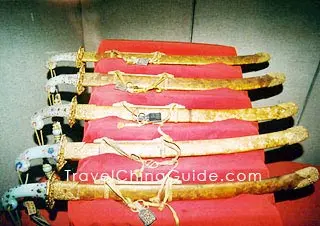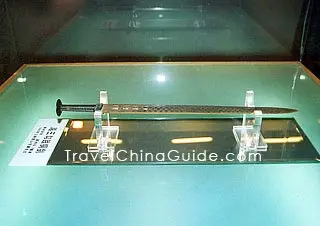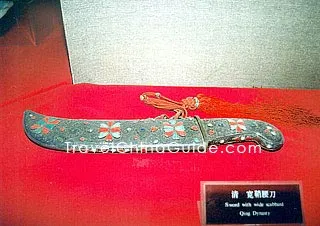There are so many varieties of ancient weapons if you have great interests to collect them. Although we have a saying 'eighteen weapons', actually it is far more than that, such as scourge, sword, spear, stick, hammer, pestle, etc. In the ancient China, Gongfu was more popular than that of today, thus weapons were quite common. To appreciate an ancient weapon, it is not enough just to value it according to the time, what you are expected to do is to assess its workmanship, whether it represents the advanced level, and whether it has relationship with historical figures.
 |
| Waist knives |
For example, most of the bronze weapons in the Spring and Autumn Period, the heyday of weapon history, are beautiful and practical with high artistic value. The sword by Gou Jian - the king of the State Yue, was still sharp without rust when discovered, and then we say it is of top grade. Many famous swords are engraved with flower patterns or posies and must be relevant to notable persons; few of common people's has that decoration. For practical ones, swords in the Qin Dynasty can be good samples because they realized the longer a sword was, the more powerful they were.
Weapons for guard of honor are mostly adorned with jewelry which raises its price.
There are three values to be noticed when appreciate a weapon. The first is the culture value. The influence and function of weaponry should not be limited in military matters. It also pervades all levels in culture. The weaponry is the symbol of power. For example, the fierce tomahawk unearthed in Fu Hao Mausoleum in Shang Dynasty (16th-11th century BC) is the symbol of Fu Hao's (a woman militarist) power. Also, weaponry can reflect a national spirit. Many poems whose verses mention weapons are full of the admiration of the qualities of braveness and self-sacrificing, which are the cherished qualities of Chinese people.
 | | Sword of Gou Jian- King of State Yue | |  | | Sword with wide scabbard | |
The second is the weapon's value of cultural relics. Some weapons, well-preserved and delicately made, are often treasured as cultural relics. But others, though being called weapons, they were actually made as playthings. For example, the iron sword with golden handle unearthed in Baoji in Shaanxi Province was high praise for its florid appearance,
exquisite flower patterns and precious stones laid in it. But it was probably the plaything or the decoration for the nobles at that time, instead of used in fighting.
The third is the weapon's value of workmanship. The ancient Chinese weapons have reached a high level. The steel blade molded in the Han Dynasty (206 BC-24 AD) was hard and sharp due to the high level of iron cast technology. The sword belonged to the King of Wu State in the Spring and Autumn Period (770 BC-476 BC) used the copper and tin melt casting skill to achieve sharp blade. These unearthed weapons all provide useful information for the research of Chinese smelting iron history and handicraft industry.
- Last updated on Aug. 08, 2025 by Gabby Li -


